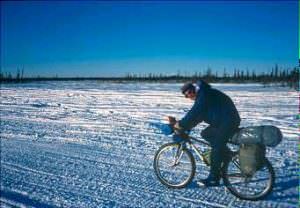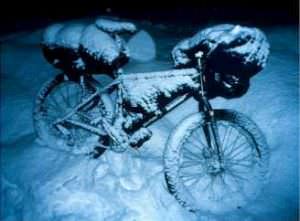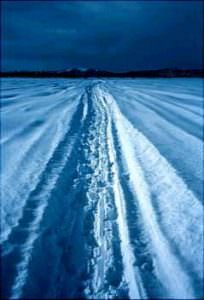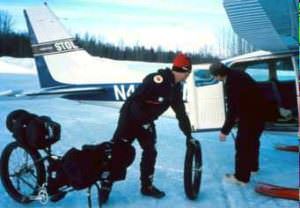Legendary among racers and largely unknown elsewhere, the Iditasport Impossible is a human-powered winter journey tracing Alaska’s historic Iditarod Trail. It’s more of an expedition than a race; we navigate unmarked dogsled and snowmachine routes 1,100 miles from Knik to Nome, and support is limited to boxes of food and clothing sent to checkpoints prior to the start.
I won the 2000 race by pedaling the Iditarod’s entire North Route; I went back in February of 2001 to attempt the South Route.
Justifying and Rationalizing
People want to know why we do this. Friends, family, reporters, all demand an explanation: Why would a person spend thousands of dollars to travel to Alaska in winter, then pay thousands more to embark on a solo journey of unthinkable difficulty through the backcountry? How can the race possibly be worth all of the risks taken?
Skeptics point out that the odds for injuring oneself, getting lost, becoming hypothermic or even dying are enormous. Further, they insist that the chance of finishing is so low that you invite depression, thoughts of failure, and second-guessing by even starting. They’re right, all of them. Still, the question lingers: Why?
Beginnings

Those who attempted to follow it would soon find themselves backtracking, walking their bikes, and even stopping snowmachines and dogsleds for directions. Bill Merchant, Gil Hjellen and I had followed a series of back trails to get to Flathorn Lake first, and had dried our gear and exhausted our meager supply of jokes before the next racer arrived half an hour later. The pre-race favorites straggled in to see Bill, Gil, and I contentedly eating burgers and steak around a fire. The mood grew sour.
Iditasport is the name of both the race and the race organization; the latter is renowned for disappointing racers by not providing the services it advertises and charges for. After 5 years of Iditasport racing, my advice to rookies is invariably, “Prepare to be self-reliant once you leave the start”.

A few years back, a furious racer predicted to Iditasport founder Dan Bull that disorganization in the race would ultimately result in the death of an unsuspecting rookie. Dan’s eyes lit up, possibly sensing an influx of media to cover such an event. Prior to every race since, Dan has boasted that he “wants a death this year”.
The ethereal beauty of a combined sun-and-moonset under clear, starry skies lulled many into believing that the night would stay crisp and sharp throughout the mandatory bivouac. To the surprise of most, that evening the skies thickened then opened, sending several inches of wind-driven snow while we slept.
Day two dawned blustery and gray with heavy snow squalls as we pushed up the Susitna and Yentna Rivers. Faster than a sub-zero bivouac might have, half a day of bike pushing through fresh snow sent the inexperienced and impatient packing. Those who’d expected a groomed highway were busy arranging to be extricated from the course, while those remaining geared down for the long haul.
Hour after hour the new snow piled up; we pushed through it while staring dizzily at a galaxy of nickel-sized flakes swirling and dancing, then refracting the beams of our headlamps before finally coming to rest.
I’d left Yentna in the early afternoon, and had ridden only a few miles before the soft trail forced me to assume the position; hands on the handlebars, feet on the ground, resigned to walking a maximum of 2 mph. A trio of racers led the race just ahead, with no one visible along the looping river bend behind.
Realizations

I came to accept that despite the planning, training, and gear testing that I’d done to get here, random, unpredictable events could occur to change the course of the race abruptly. Examples:
- -60 miles into the 1997 Iditasport I stepped into a hole left by a moose, tearing the MCL and meniscus in my left knee.
- -In 1998 I arrived at the Skwentna checkpoint hungry and out of food. An anxious search for my food box turned up nothing; Iditasport hadn’t sent it. Facing a 75-mile ride into the Alaska Range before the next re-supply, I scrounged a bag of chips and a candy bar from a fellow racer.
- -After 3 difficult days of travel into the heart of the Alaska Range in 1999, I scratched at the Rainy Pass checkpoint due to extremely high avalanche hazard. I thought it suicidal to continue.
Scenarios like these are common in Iditasport races. Racers entering backcountry events must willingly accept accidents and unpredictable weather as possibilities; neither a blown knee nor avalanche hazard could have been planned for. But with the odds stacked unfavorably, we’re wholly dependent on the race organization to provide basic services like shipping out food boxes. Iditasport’s failure to send my critical supplies was inexcusable and, sadly, common.
Foreshadowing
At twilight the snow continued to fall thick and wet, the unmarked trail had disappeared beneath over a foot of fresh, and I had three motivated rabbits ahead sniffing out the firmest track. I felt at ease; the circumstances were similar to every Iditasport I’d participated in.
The trails we follow lead north and west. They are so infrequently marked that we become accustomed to feeling with our feet and tires for the firmest, most traveled trail, hoping it will take us to the next checkpoint directly.
Often the trickiest route finding is getting out of the checkpoints and back onto the right trail without ending up at an outhouse or fishing hole. Even if we manage to follow the best trail, sometimes it rounds a bend, fades into the forest and abruptly ends at the upturned roots of a downed tree.
Progressing up the river it became increasingly difficult to keep track of time. I chided myself for failing to notice the sunset, but before I got too deep into my mini-lecture about “remembering why I was out here” I realized that there hadn’t been one. The close, dirty gray sky of day had slid imperceptibly into the closer and much darker gray of night.
Sometime in the dark hours skier Bob Baker appeared from the maelstrom. We spent a few minutes comparing notes about our trips to Nome (he skied there in 1989) before he pulled ahead. The tiny halo from my battery-powered headlamp was no match for the intensity of the wind-driven snow.
I tried keeping Bob’s bright orange suit in sight but he was quickly reabsorbed by the storm. Using his vanishing tracks as a motivator, I found that if I alternated running and walking every few minutes I could stay close enough to hear the metronomic click of his poles striking the snow.
Complications

An abnormally warm winter had frozen the rivers poorly, and Bob’s weight had collapsed a patch of thin ice covered by new snow. It probably looked the same as everything he’d skied that day, and I’ll bet his heart nearly exited his chest when the ice broke, but fortunately his skis spread the weight out and kept him from getting wet.
Between gusts of wind I caught glimpses of Bob’s headlamp beam scanning the river ahead, but soon his tracks were no longer beneath my feet. Without a trail I floundered hopelessly in the waist deep snow, reaching up to grasp my handlebars. Anxiously searching for a platform to walk on, I broke through the ice and into the river. Instinct took over: I flattened myself on the ice to spread my weight out, then wiggled forward, pulling my legs out of the water. I crawled a short distance to what I thought was solid ice, but when I tried to stand I broke through again.
I’ll never forget the sensation of struggling to get myself back on top of the ice as the current of the glacier-fed river tugged at my legs below. I spent an exhausting, hyperventilating eternity crawling to a safer spot, dragging my bike behind. Regaining the trail on the north side of the river, I brushed the congealing slush and snow off of my suit while collecting myself; several minutes passed before I stopped shaking and normal breathing returned.
Sharp pain in my left ankle brought me back to reality: I’d wrenched it forcefully when I broke through the first time, but only from the relative safety of the trail did the pain begin to register. A few stars appeared overhead as I limped gingerly through that night, arriving at Skwentna as a hint of dawn came into the eastern sky. curiak4.jpg (16243 bytes)
Spiraling Downward
I iced my ankle and took some Naproxen to limit the swelling, then spent a few hours napping, eating, and drying wet clothing. I wrapped the swollen joint firmly to immobilize it, then left Skwentna under heavy skies with intermittent rain and snow showers. I stopped often to pack snow around my ankle, but after nine hours of walking the range of motion was gone and the pain was bringing me to my knees with regularity.
Hobbling into Shell Lake at dusk, I headed for an outbuilding to convalesce. I hung my wet gear over the oil stove to dry, then arranged myself so that I could keep my ankle elevated with bags of snow on it. After a fitful night the first rays of sun backlit the Shell Hills, and I knew it was time to move. My ankle was not in agreement I simply couldn’t place weight on it. With an extraordinary amount of pain I was able to shuffle downhill to the main cabin.
Disillusionment
Inside it’s a frenzy of activity as 40 athletes eat, nap, and dry wet gear. The mood is one of cynicism and anger; veterans and rookies alike agree that this is the most disorganized event they’ve ever entered. It’s unanimous that a two thousand dollar entry fee should have bought, at a minimum, a marked trail and some trailbreakers.
One frustrated racer remarks that, “For that price we should get sex at every checkpoint”. Many didn’t receive their supply boxes at Skwentna, and wonder aloud about the likelihood that they’ll get them at the more remote outposts. An Iditasport veteran across the room allows that past experience tells him, “Not to hold his breath”.
Resignation

I gaze out a window as the falling snow engulfs my bike. I feel ridiculous answering the question of “What are you still doing here?” to every racer and media type that walks through the door. I had high expectations to get myself all the way back to Nome. I’d expected to be slowed by 80 mph winds, feet of snow and 40 below cold, but never expected to be stopped by an injured ankle.
I continue the icing and elevating routine while scratching this account on a borrowed legal pad, occasionally offering tidbits of course knowledge to inquisitive racers filing through. After 36 hours at Shell Lake, the weather lifts enough that many of us can be flown backwards over the course to Anchorage. Two to three days of laborious travel on the ground equates to 25 minutes in the small aircraft.
Fred Bull, an Iditasport employee, is at the hangar when we arrive. Stepping off the plane, fellow racer Alicja Barahona suggests to him that the race organization is “not good”, but Fred cuts her off with “This race is a huge hassle to organize”. I wonder aloud, “Then why bother?” Fred offers no response. Alicja starts again firmly, “I brought several friends over from Europe to race. You took their money, but you gave them no map, no course markings, nothing”. Fred snaps back, “Well maybe you shouldn’t come back next year”. The conversation ends.
Finality
Hours later in Anchorage, resuming the icing and elevating position in a quiet corner of a bed and breakfast, I have time to reflect. I feel nauseated and hollow I long to be out there. Faced with an early and unwanted end to my annual pilgrimage, I’m returned to a society and existence that seem, by comparison, only trivial and mundane.
Considering the time and money spent, I’m dejected to be here while others continue on, and angry with Iditasport for their laissez faire approach to race promotion. Emotions conflict and confusion reigns through the afternoon; I catch myself blaming people, circumstances and weather for my predicament.
I play the coulda-shoulda-woulda game for hours before I’m drawn out of my self-abuse by the rhythmic drip-drip-drip of meltwater leaking from the ice pack at my ankle. I limp outside to clear my head and refocus. At the moment only this much is clear: I knew the chance of finishing was slim. I can fault no one for the way my race ended.
Why’ revisited
Right up to the minute before race start I’d been asked to explain why I do this. I’d explained that I attempt races like this not despite the risks but because of them. I come looking for a supreme challenge, trying to achieve the most arduous task conceivable, and I believe the outcome must be in question until the very last moments otherwise it is no challenge at all.
I see it as a pilgrimage, an opportunity to find some clarity by substituting the hardships of life on the trail for the trivialities of daily existence. Rarely are those who’ve asked satisfied by my simple answers. To their chagrin, the complete answer is simple.
Fellow racer Bill Merchant said it best, “We go into the Alaskan backcountry to find cracks in ourselves. We go back a year later to see if we’ve done anything about them”.
Should you have any questions or require further clarification on the topic, please feel free to connect with our expert author Mike Curiak by leaving a comment below. We value your engagement and are here to assist you.
